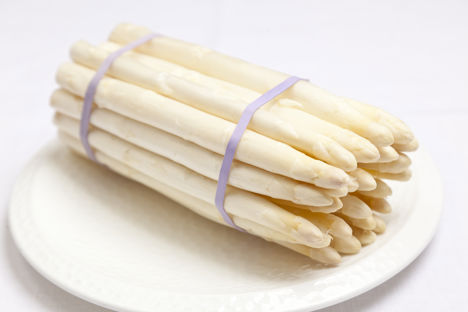
Ingredient focus: white asparagus
Sally Abé turns her attention to one of her favourite vegetables of all time – the carefully grown white asparagus.
View more from this series:
Ingredient focusWhite asparagus is the same as the more familiar green widely sold in the UK – the only difference is that whilst growing it is not exposed to light, and therefore contains no chlorophyll. As the asparagus grows, soil is piled over the budding stem to shield it from the sunlight. In season between April and June, the majority of white asparagus is grown in the Alsace region of France and in Germany where it takes priority over the green stems we favour here in the UK. The production of white asparagus is a very labour intensive process as each stem has to be harvested by hand, which results in a comparatively hefty price tag.
Flavour profile
Some may claim that there is little difference in flavour between white and green asparagus but the absence of chlorophyll most certainly has an effect on the flavour of the stems.
White asparagus differs to green in that it is sweeter but also has a slight bitterness that is mellowed through cooking. Its flavour is subtle and delicate which is best drawn out by gentle cooking methods such as steaming and low simmering. It requires peeling prior to cooking (unlike green asparagus), as the flavour of the skin is too bitter to eat. However, the peelings are sometimes added back to the cooking liquor to boost the flavour without the bitter notes.
The main aromas found in white asparagus are green, herbal and spicy but there are also smoky, nutty and creamy aromas present. This makes white asparagus compatible with a wealth of other ingredients.
Food matches
In Europe, white asparagus is traditionally eaten with a rich sauce such as hollandaise or simply melted butter and salty ham, but it is much more versatile than these classic pairings. The green aromas found in white asparagus complement those found in coffee, making them a great – if a little unusual – match. The same applies for chocolate. The herbal notes in white asparagus are also similar to those found in pine nuts, making the two ingredients a fantastic combination.
White asparagus has a subtle enough flavour to be matched with both meat and fish dishes. Alyn Williams pairs it with beef and craft ale while Adam Gray serves his with duck, peas and a Meantime beer gravy. Both chefs use beer, as the bitterness of the hops balances the sweetness of the asparagus.
David Kelman’s dish of Roast fillet of cod with saffron potatoes and tomatoes makes a light, summery meal, while James Sommerin’s Goat’s cheese custard and asparagus plays on the traditional accompaniment of hollandaise and makes a great vegetarian option.
Did you know?
White asparagus turns pink when exposed to sunlight; some farmers leave the very tips exposed before harvesting to achieve a colourful finish.
It takes three years before an asparagus plant produces its first tip.
The city of Schwetzingen in Germany calls itself the ‘white asparagus capital of the world’ and holds an asparagus peeling contest every year.


